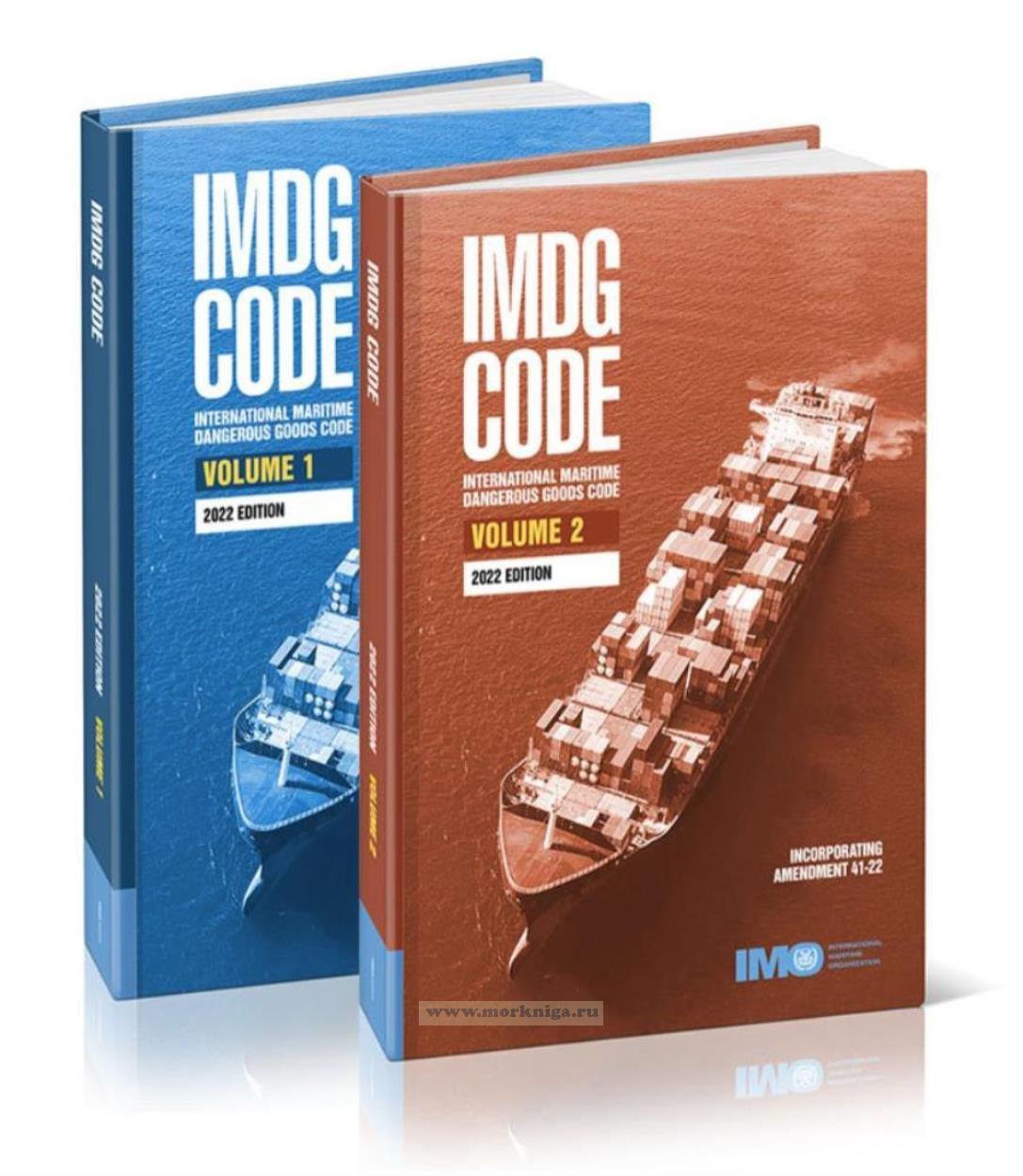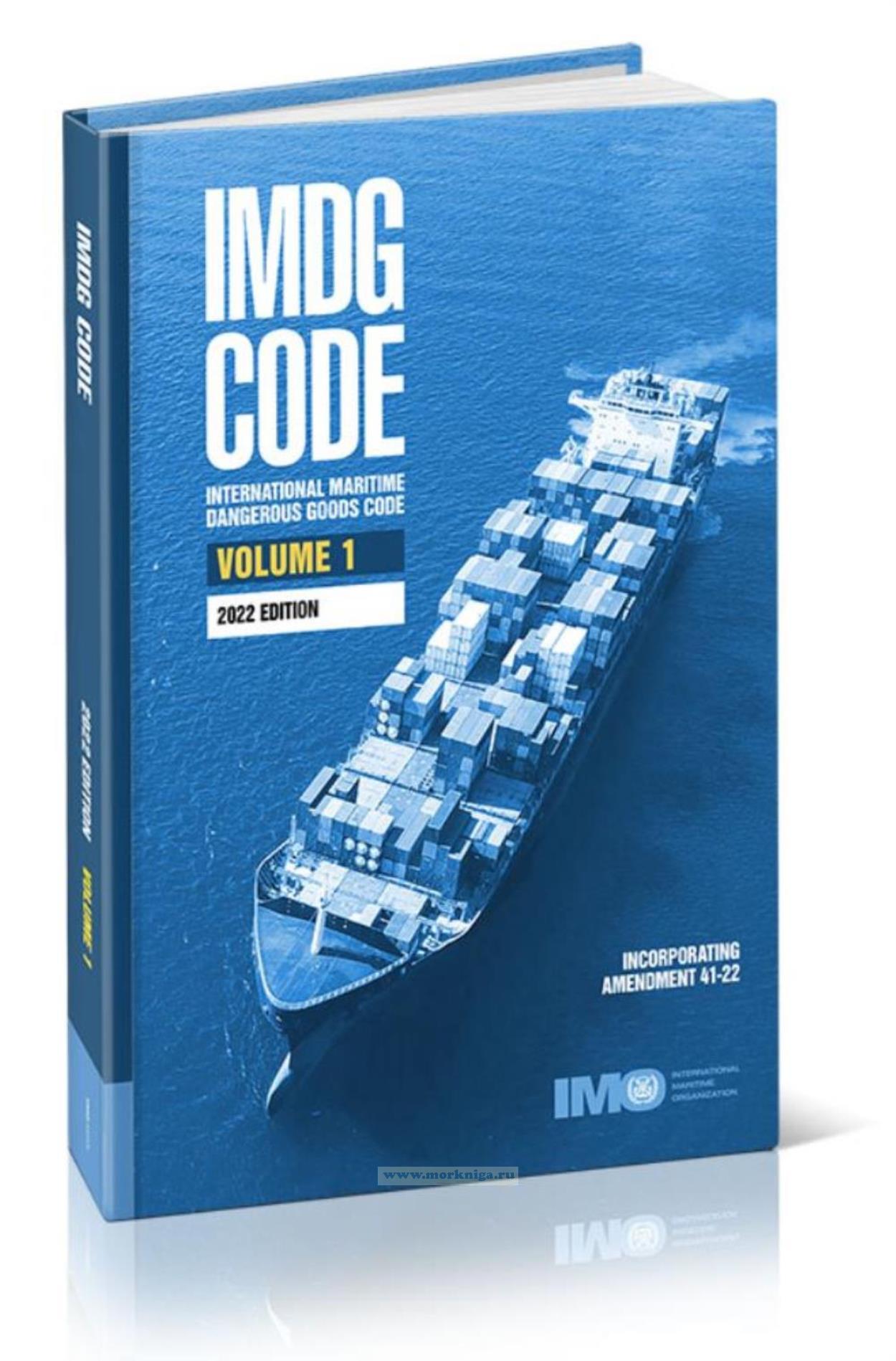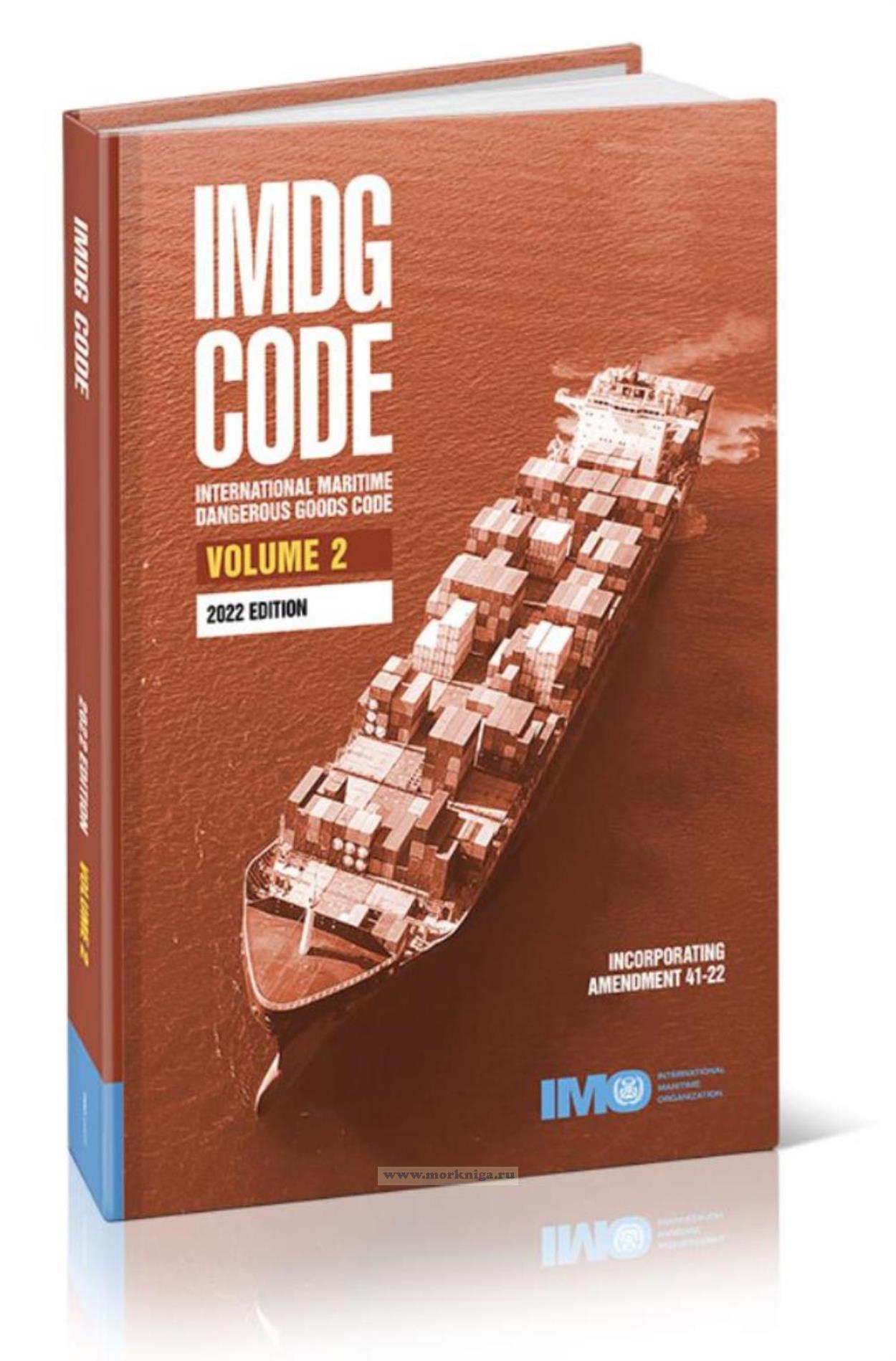IMDG Code. International Maritime Dangerous Goods Code. Volume 1 and Volume 2. 2022 Edition/Международный кодекс морской перевозки опасных грузов в 2-х томах. Издание 2022 года
Издание 2022 года будет добровольным с 1 января 2023 года и станет обязательным с 1 января 2024 года.
Книга на английском языке
The International Convention for the Safety of Life at Sea, 1974 (SOLAS), as amended, deals with various aspects of maritime safety and contains in chapter VII the mandatory provisions governing the carriage of dangerous goods in packaged form or in solid form in bulk. The carriage of dangerous goods is prohibited except in accordance with the relevant provisions of chapter VII, which are amplified by the International Maritime Dangerous Goods Code (IMDG Code).
Regulation II-2/19 of the SOLAS Convention, as amended, specifies the special requirements for a ship intended to carry dangerous goods, the keel of which was laid or which was at a similar stage of construction on or after 1 July 2002.
The International Convention for the Prevention of Pollution from Ships, 1973, as modified by the Protocol of 1978 relating there to (MARPOL), deals with various aspects of prevention of marine pollution, and contains in its Annex III the mandatory provisions for the prevention of pollution by harmful substances carried by sea in packaged form. Regulation 1(2) prohibits the carriage of harmful substances in ships except in accordance with the provisions of Annex III, which are also amplified by the IMDG Code.
In accordance with the Provisions concerning Reports on Incidents Involving Harmful Substances (Protocol I to MARPOL), incidents involving losses of such substances from ships must be reported by the master or other person having charge of the ship concerned.
The IMDG Code that was adopted by resolution A.716(17) and amended by amendments 27 to 30 was recommended to Governments for adoption or for use as the basis for national regulations in pursuance of their obligations under regulation VII/1.4 of the 1974 SOLAS Convention, as amended, and regulation 1(3) of Annex III of MARPOL. The IMDG Code, as amended, attained mandatory status from 1 January 2004 under the umbrella of SOLAS; however, some parts of the Code continue to be recommendatory. Observance of the Code harmonizes the practices and procedures followed in the carriage of dangerous goods by sea and ensures compliance with the mandatory provisions of the SOLAS Convention and of Annex III of MARPOL.
The Code, which sets out in detail the requirements applicable to each individual substance, material or article, has undergone many changes, in both layout and content, in order to keep pace with the expansion and progress of industry.
IMO’s Maritime Safety Committee (MSC) is authorized by the Organization’s Assembly to adopt amendments to the Code, thus enabling IMO to respond promptly to developments in transport.
The MSC at its one hundred and fifth session agreed that, in order to facilitate the multimodal transport of dangerous goods, the provisions of the IMDG Code, 2022 edition, may be applied from 1 January 2023 on a voluntary basis, pending their official entry into force on 1 January 2024 without any transitional period. This is described in resolution MSC.501(105) and the Preamble to this Code. It needs to be emphasized that, in the context of the language of the Code, the words “shall”, “should” and “may”, when used in the Code, mean that the relevant provisions are “mandatory”, “recommendatory” and “optional”, respectively.
См. также предыдущее издание IMDG Code 2020 года и IMDG Code. International Maritime Dangerous Goods Code. Supplement. 2022 Edition/Дополнения к Международному кодексу морской перевозки опасных грузов. Издание 2022 года.
См. также издание 2024 года.
Contents
Volume 1
Foreword
Preamble
Part 1 General provisions, definitions and training
Chapter 1.1 General provisions
Chapter 1.2 Definitions, units of measurement and abbreviations
Chapter 1.3 Training
Chapter 1.4 Security provisions
Chapter 1.5 General provisions concerning radioactive material
Part 2 Classification
Chapter 2.0 Introduction
Chapter 2.1 Class 1 – Explosives
Chapter 2.2 Class 2 – Gases
Chapter 2.3 Class 3 – Flammable liquids
Chapter 2.4 Class 4 – Flammable solids; substances liable to spontaneous combustion; substances which, in contact with water, emit flammable gases
Chapter 2.5 Class 5 – Oxidizing substances and organic peroxides
Chapter 2.6 Class 6 – Toxic and infectious substances
Chapter 2.7 Class 7 – Radioactive material
Chapter 2.8 Class 8 – Corrosive substances
Chapter 2.9 Miscellaneous dangerous substances and articles (class 9) and environmentally hazardous substances
Chapter 2.10 Marine pollutants
Part 4 Packing and tank provisions
Chapter 4.1 Use of packagings, including intermediate bulk containers (IBCs) and large packagings
Chapter 4.2 Use of portable tanks and multiple-element gas containers (MEGCs)
Chapter 4.3 Use of bulk containers
Part 5 Consignment procedures
Chapter 5.1 General provisions
Chapter 5.2 Marking and labelling of packages including IBCs
Chapter 5.3 Placarding and marking of cargo transport units and bulk containers
Chapter 5.4 Documentation
Chapter 5.5 Special provisions
Part 6 Construction and testing of packagings, intermediate bulk containers (IBCs), large packagings, portable tanks, multiple-element gas containers (MEGCS) and road tank vehicles
Chapter 6.1 Provisions for the construction and testing of packagings
Chapter 6.2 Provisions for the construction and testing of pressure receptacles, aerosol dispensers, small receptacles containing gas (gas cartridges) and fuel cell cartridges containing liquefied flammable gas
Chapter 6.3 Provisions for the construction and testing of packagings for class 6.2 infectious substances of category A (UN 2814 and UN 2900)
Chapter 6.4 Provisions for the construction, testing and approval of packages for radioactive material and for the approval of such material
Chapter 6.5 Provisions for the construction and testing of intermediate bulk containers (IBCs)
Chapter 6.6 Provisions for the construction and testing of large packagings
Chapter 6.7 Provisions for the design, construction, inspection and testing of portable tanks and multiple-element gas containers (MEGCs)
Chapter 6.8 Provisions for road tank vehicles and road gas elements vehicles
Chapter 6.9 Provisions for the design, construction, inspection and testing of bulk containers
Chapter 6.10 Provisions for the design, construction, inspection and testing of portable tanks with shells made of fibre-reinforced plastics (FRP) materials
Part 7 Provisions concerning transport operations
Chapter 7.1 General stowage provisions
Chapter 7.2 General segregation provisions
Chapter 7.3 Consigning operations concerning the packing and use of cargo transport units (CTUs) and related provisions
Chapter 7.4 Stowage and segregation on containerships
Chapter 7.5 Stowage and segregation on ro-ro ships
Chapter 7.6 Stowage and segregation on general cargo ships
Chapter 7.7 Shipborne barges on barge-carrying ships
Chapter 7.8 Special requirements in the event of an incident and fire precautions involving dangerous goods
Chapter 7.9 Exemptions, approvals and certificates
Volume 2
Note
Part 3 Dangerous goods list, special provisions and exceptions
Chapter 3.1 General
Chapter 3.2 Dangerous Goods List
Chapter 3.3 Special provisions applicable to certain substances, materials or articles
Chapter 3.4 Dangerous goods packed in limited quantities
Chapter 3.5 Dangerous goods packed in excepted quantities
Appendices
Appendix A List of generic and N.O.S. proper shipping names
Appendix B Glossary of terms
Index


